Share the post "Soccer Field Dimensions/Markings (Pro/School/Youth)"
The size of a soccer field can vary; teams use different sizes to suit their style of play. A small field can restrict an opponent from playing their natural game.
The size of a soccer field has guidelines so that you can select a size of field within those boundaries. We’ll take a look at the specifics for all levels later on.
Here are some of the key points we’ll cover in this article;
- Surface Types of soccer fields
- How a soccer field is marked
- The dimensions of a soccer field for all ages
- Goal frames and technical areas
All the information you’re about to discover is from the official sources, so you’ll know exactly how big a soccer field is, so you’ll be able to set up a soccer field for youth, school, college, and pro.
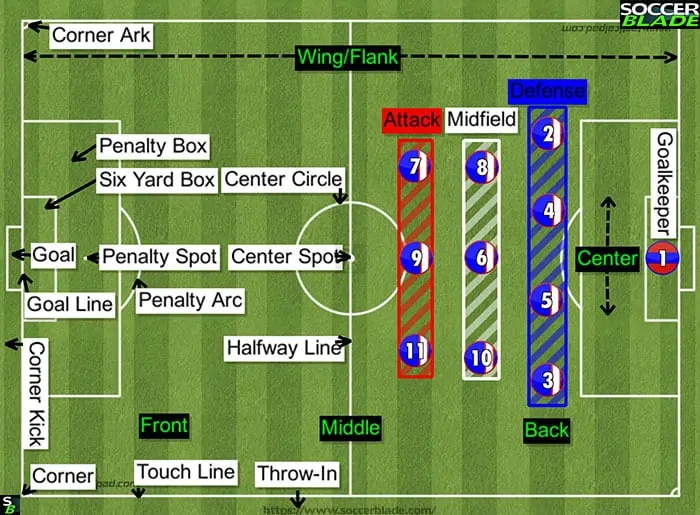
Soccer Field Surface
The soccer field can be either natural turf, artificial turf, or a combination of the two. The color needs to be green.
The quality of the field for a FIFA competition game needs to be of the standard of the FIFA Quality Programme for Football Turf.
This is unless the International Football Association Board permits it.
Most soccer fields in the Premier League are now a combination of natural and artificial turf. This is to prevent the field from being damaged during the winter months when there’s heavy rain and less heat.
This has only been the case in the last 10 years. Before this, soccer fields were difficult to play on, as heavily used areas like the penalty box became muddy during the winter and fall.
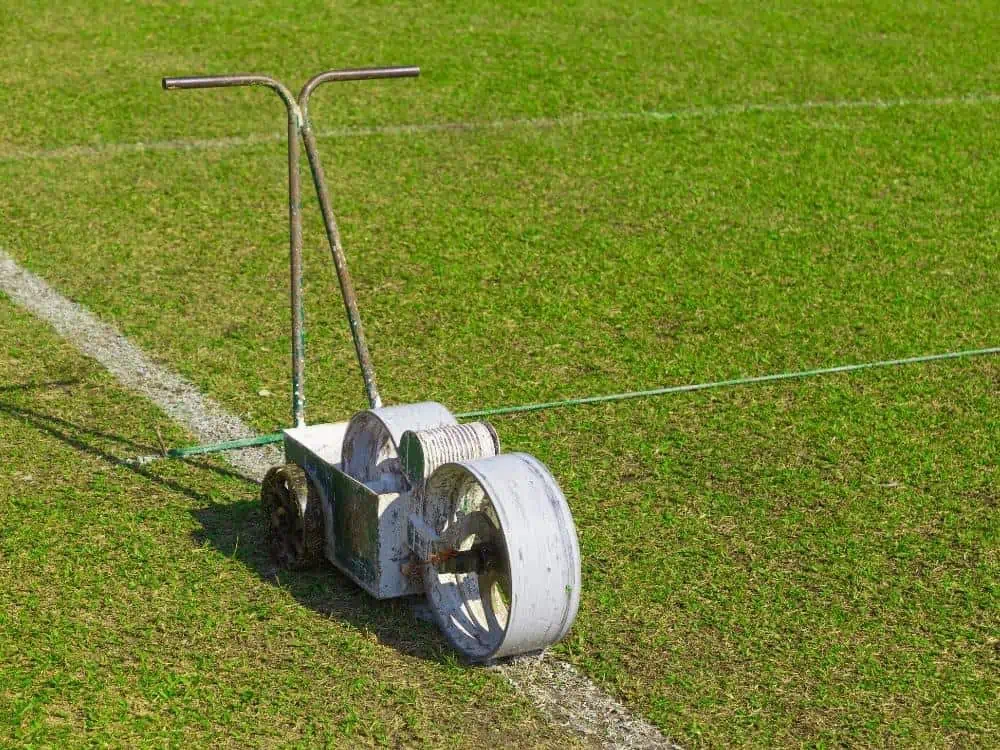
How a Soccer Field is Marked
The field must be marked to show the sections in a continuous line. The lines must be of the same thickness. The thickness of the lines should not be more than 12cm wide.
Various precisely measured marks are chalked in white within the soccer field’s outer edges.
These are hand-painted and frequently require at least two layers to achieve the desired brightness. On game days, they are commonly repainted following the final cutting of the turf just a few hours before kick-off.
The touchlines are the two more extensive boundary lines, while the goal lines are the shorter lines. A midway line connects the center points of the two touch lines, dividing them into two halves.
The areas of a soccer field that are to be marked are;
- Touchlines
- Halfway line
- Center mark
- Center circle
- Corner arks
- Goal lines same width as posts + crossbar
- Lines less than 12 cm/5 inches
According to the International Football (Soccer) Association Board — a regulatory body that develops soccer laws;
A soccer field must be rectangular and demarcated with unbroken lines.
IFAB Law 1 – The Field Of Play
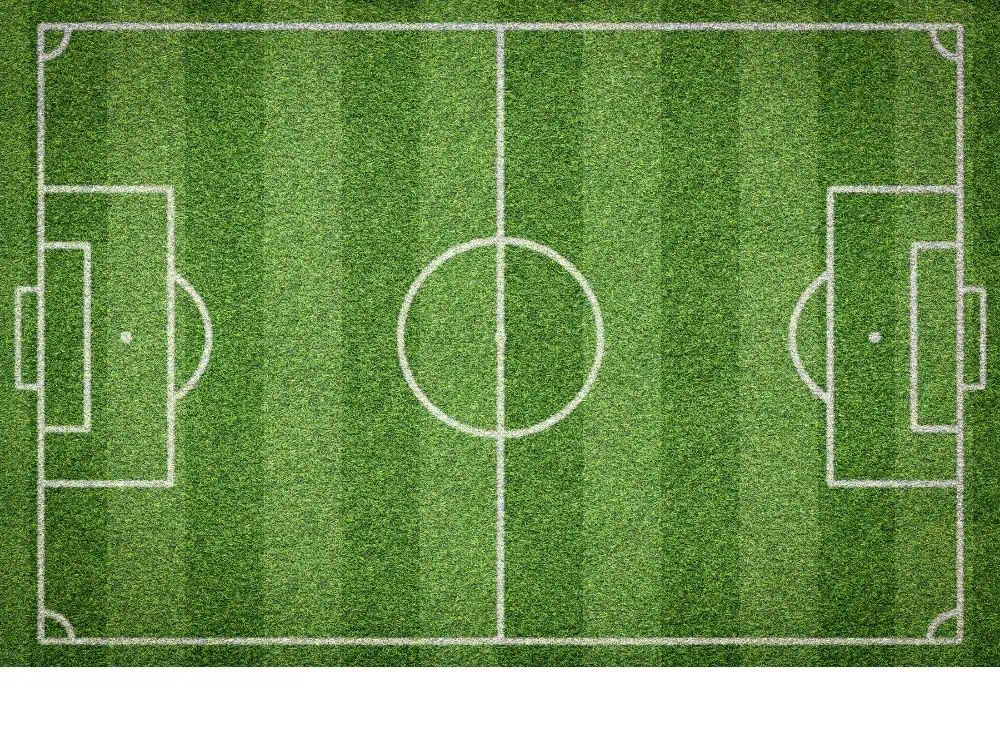
Halfway Line and Center Circle
The midway of the halfway line is where the center mark is located. It is surrounded by a circle whose radius measures 9.15 meters.
To ensure that defensive players stay away from the ball during a corner kick, marks are made 9.15m away from the corner arc and perpendicularly to the goal lines and touchlines. All the lines are no wider than 12cm.
What Happens If Someone Changes The Marks on a Soccer Field?
It has happened in the past where a player has deliberately ‘scuffed’ the goal spot to make a hole before a penalty has been taken. They’ve done this to distract a player and cause the ball to shoot up over the bar.
Here are the official rules if someone tries to change the marks on a soccer field.
A player who makes unauthorized marks on the field of play must be cautioned for unsporting behavior. If the referee notices this being done during the match, the player is cautioned when the ball next goes out of play.
IFAB
Look at this video from the German league where the goalkeeper cuts up the turf with his cleats!
What if A Different Sport Has Been Played on The Same Field?
In the UK, rugby is played on a soccer field the previous week to when a soccer game is being played. A rugby field is marked out differently than soccer. It’s difficult to remove the white chalk from the field so they can be painted differently.
Here’s the official rule for different marks on a soccer field;
If a different game marks a field, those lines need to be a different color, and you must be able to tell they’re not a part of the game.
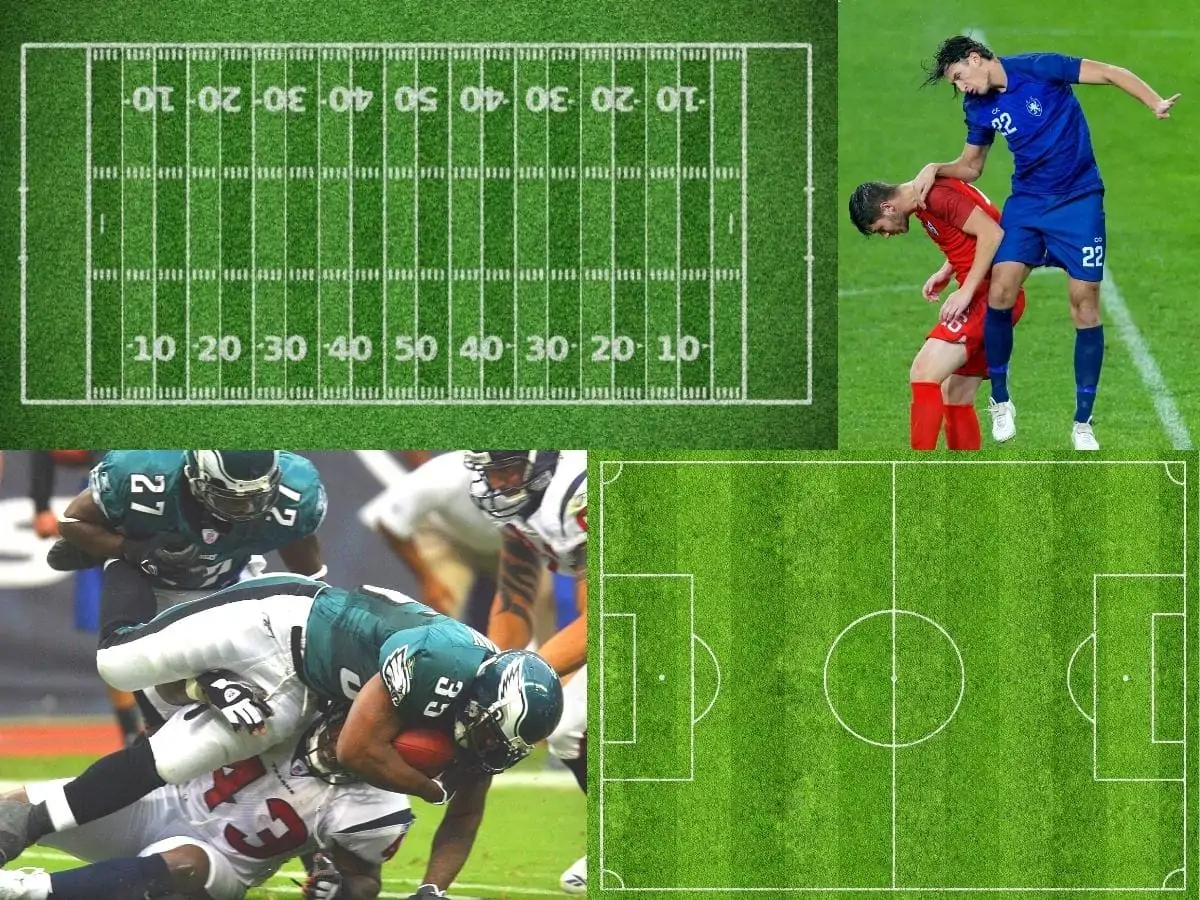
Are Soccer Fields Bigger than Football Fields?
Some soccer fields are smaller than football fields, and some are larger. An American soccer field is 120 yards long and 53 yards wide. The smallest soccer field can be is 100 yards long and 50 yards wide. The biggest it can be is 130 yards long and 100 yards wide.
If you’ve ever raced laps, you’ve undoubtedly grumbled about how big soccer fields are. According to FIFA regulations, there are allowed ranges for the length and width of a soccer field.
Surprisingly, most sports fields are larger than traditional American or Canadian football fields.
- The usual width of an American football field is 53 1/3 yards, but Canadian football fields are marginally larger at 65 yards.
Thus, whereas a football field fits within the dimensions of a soccer field, a soccer field will almost certainly be bigger than a football field.
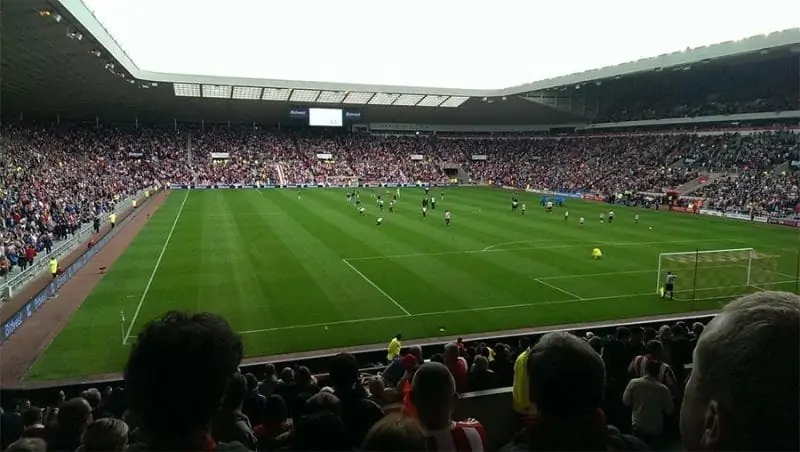
What Are The Dimensions Of A Soccer Field?
A full-size field can range in width from 50 to 100 yards and length from 100 to 130 yards.
Here are the soccer field dimensions for all measurement types.
11 vs. 11 Soccer Field Dimensions in Yards
| Width | Length | ||
| Minimum (Yards) | 50 | 100 | |
| Maximum (Yards) | 100 | 130 |
- The minimum area in square yards is: 5,000 sq. yd.
- The maximum area in square yards is: 13,000 sq. yd.
11 vs 11 Soccer Field Dimensions in Meters
| Width | Length | ||
| Minimum (Meters) | 45 | 90 | |
| Maximum (Meters) | 90 | 120 |
- The minimum area in square yards is: 4,050 sq. m.
- The maximum area in square yards is: 10,800 sq. m.
11 vs 11 Soccer Field Dimensions in Feet
| Width | Length | ||
| Minimum (Feet) | 147 | 295 | |
| Maximum (Feet) | 295 | 394 |
- The minimum area in square yards is: 43,365 sq. ft.
- The maximum area in square yards is: 116,230 sq. ft.
11 vs 11 Soccer Field Dimensions in Inches
| Width | Length | ||
| Minimum (Inches) | 1771.65 | 3543.31 | |
| Maximum (Inches) | 3543.31 | 4724.41 |
International Soccer Field Dimensions
Here are the measurements for games played at the World Cup and all national games.
| Meters | Yards | |
| Length – Touch Line | 100-110 | 110-120 |
| Width – Goal Line | 64-75 | 70-80 |
US Youth Soccer Field Sizes
Details for all US youth soccer, from under 6’s to under 19’s: US Youth Soccer
| Age | Game Minutes | Ball Size | Players | Goal feet | Width yards | Length yards |
| u17-u19 | 2 x 45 | #5 | 11 vs 11 | 8 x 24 | 50-100 | 100-130 |
| u15-u16 | 2 x 40 | #5 | 11 vs 11 | 8 x 24 | 50-100 | 100-130 |
| u13-u14 | 2 x 35 | #5 | 11 vs 11 | 8 x 24 | 50-100 | 100-130 |
| u11-u12 | 2 x 30 | #4 | 9 vs 9 | 7 x 21 | 45-70 | 70-80 |
| u9-u10 | 2 x 25 | #4 | 7 vs 7 | 6 x 18.5 | 35-45 | 55-65 |
| u6-u8 | 4 x 10 | #3 | 4 vs 4 | 4 x 6 | 15-25 | 25-35 |
High School Soccer Field Dimensions
The dimensions for a soccer field for the United States high schools are the same as above for the center circle, penalty area, goal area, penalty spot, and corner arks.
The only difference is the length of the touchline and the goal line.
| Minimum Yards | Maximum Yards | |
| Length – Touchline | 100 | 120 |
| Width – Goal line | 55 | 80 |
Indoor Soccer Field Dimensions
The recommended size of a US indoor soccer field is 67 yards long and 28 yards wide. The penalty mark is 8 yards from the goal.
The goals are 8 feet by 14 feet. This is from the Ohio High School Soccer Association.
The goal area is not a standard international shape, so check against your local competition regulations.
| Minimum Yards | Maximum Yards | |
| Length – Touchline | 58 | 70 |
| Width – Goal line | 25 | 33 |
Futsal Field Dimensions
Futsal field dimensions for the United States from U.S. Futsal;
| Minimum | Maximum | |
| Width – yards | 16 | 27 |
| Length – yards | 27 | 45 |
International futsal field dimensions from Wikipedia;
| Minimum | Maximum | |
| Width – yards | 21.9 | 27.3 |
| Length – yards | 41.5 | 45.9 |
Soccer Field vs NFL Football Field: Comparison
| Soccer Field | Football Field | |
| Width – yards | 50-100 | 53.33 |
| Length – yards | 100-130 | 100 (120 apexes) |
Goal Area Size
The goal area, sometimes known as the 6-yard box, is measured from the goalposts, 6 yards or 5.5 meters parallel to the goal line.
At 6 yards/5.5m of the inside of every goalpost, two lines are drawn perpendicularly to the goal line. These lines extend 6 yards/5.5 meters into the playing field and are connected by a line drawn straight to the goal line.
The goal area is defined as the region limited by this line and the goal line – where the goal kick is taken from.
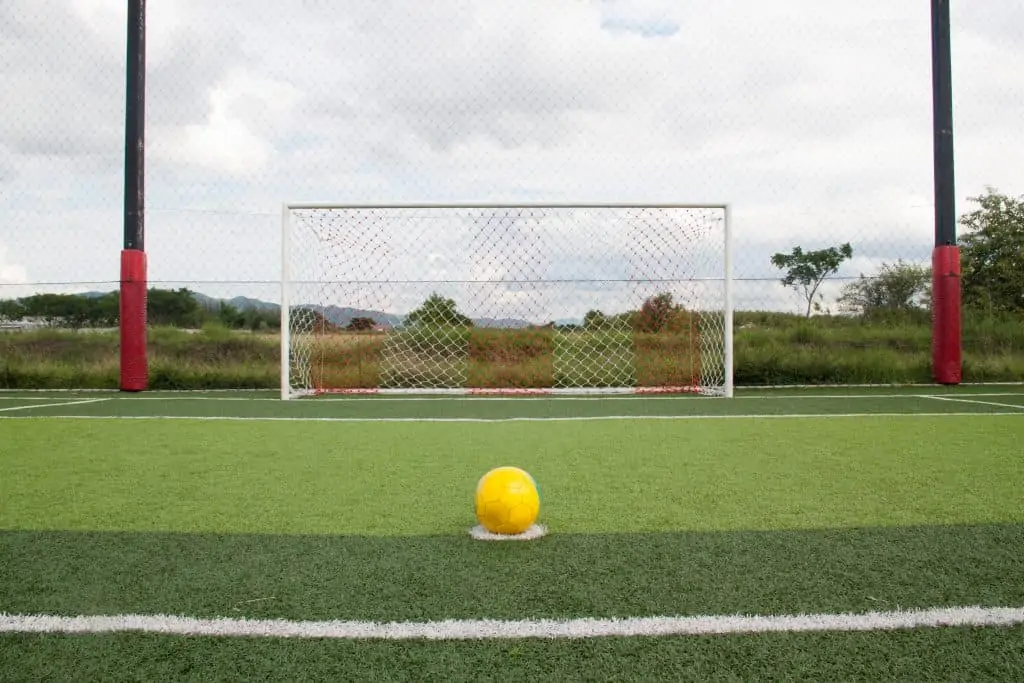
Penalty Area Size and Position
The penalty area is 18 yards/16.5 m from inside every goalpost, two lines are drawn at sharp angles to the goal line.
These lines are connected by a line drawn opposite the goal line, extending 18 yards/16.5 m into the playing field.
The penalty area is the area between these lines and the goal line. A penalty post is placed 12 yards/11 meters from the midway between the goalposts and equal to them within each penalty area.
Outside the penalty area, a circle’s 10-yard/9.15m diameter arc is formed from the middle of each penalty mark.
- The penalty area is measured at 18 yards/16.5 meters from the inside of the post.
- The penalty mark is measured from the middle of the goalposts to 12 yards/11 meters.
- Ark – Measured from the penalty mark at 10 yards/9.15 meters
FIFA Soccer Field Dimensions Graphic
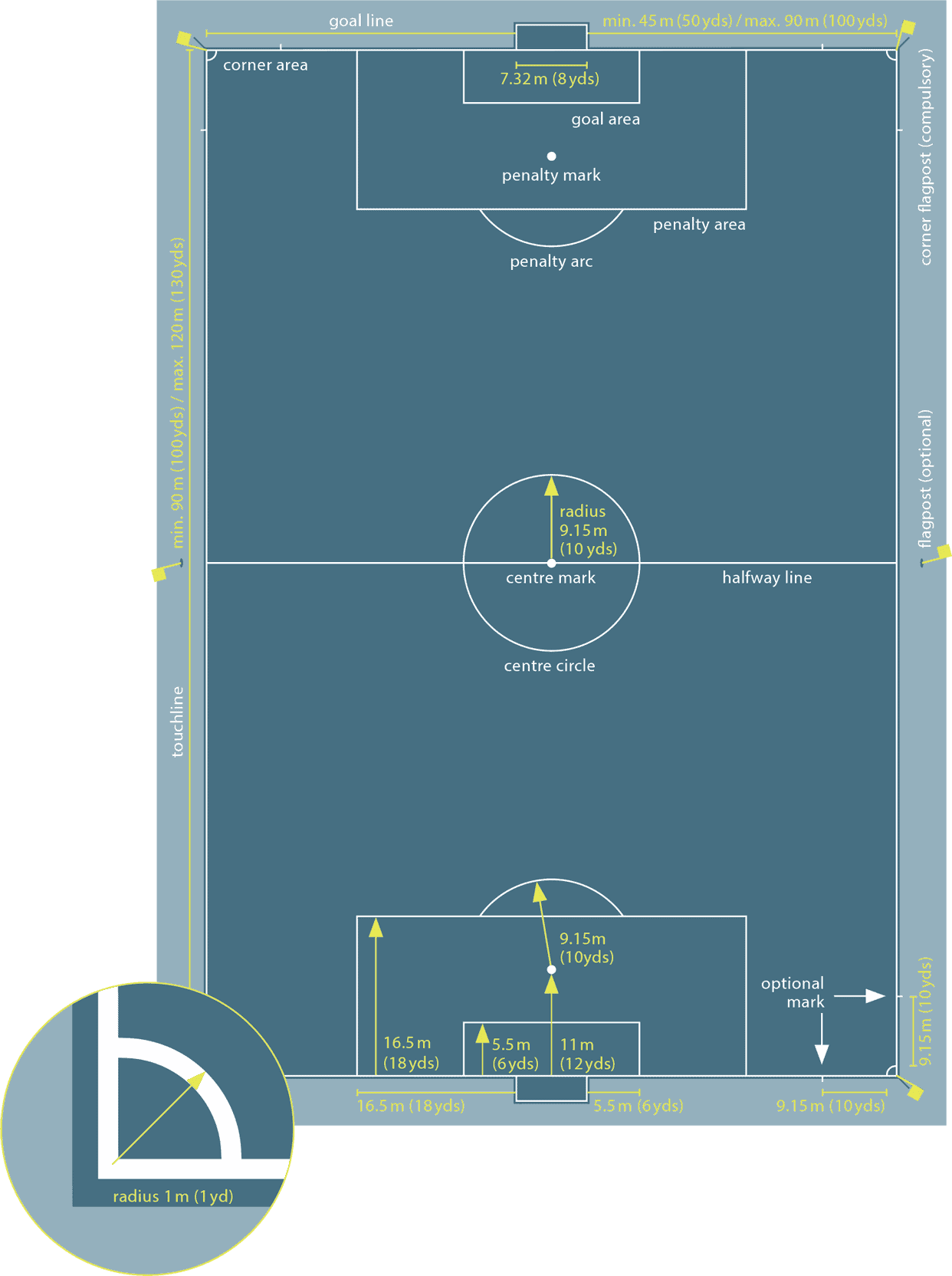
Corner Flag
At each corner of the soccer field, the corner flag is a quarter circle and 1 yard from the goal line/touchline. The flagpost should not be shorter than 5 feet/1.5 meters, and a flag must be set to have a non-pointed tip.
If desired, a flag post can be placed at each end of the midway line. This isn’t required, but it can be done. A flag post must be at least a single yard off the touchline if it is set at the ends of the half-line.
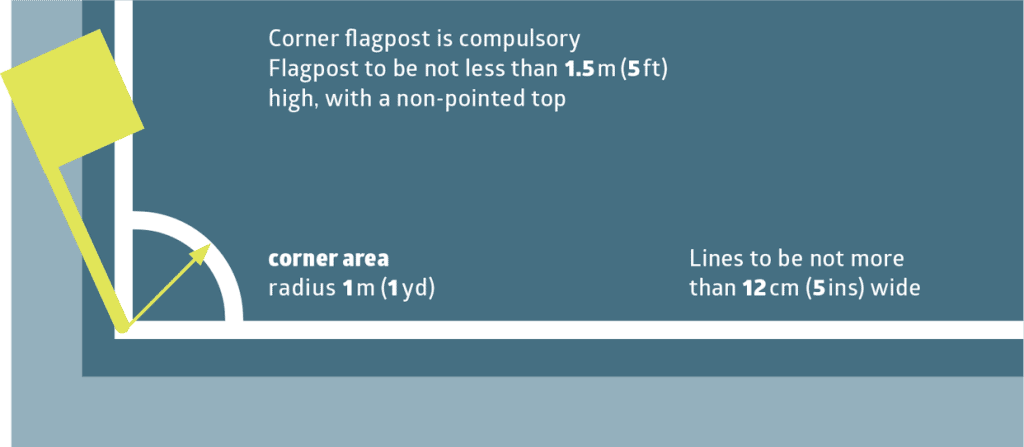
Technical Areas
The technical is for the coaches to give instructions. The measurement must be no wider than 1 yard/1 meter from the seating area and no closer than 1 yard/meter from the touchline.
Only one person can give instructions from the area at a given time.
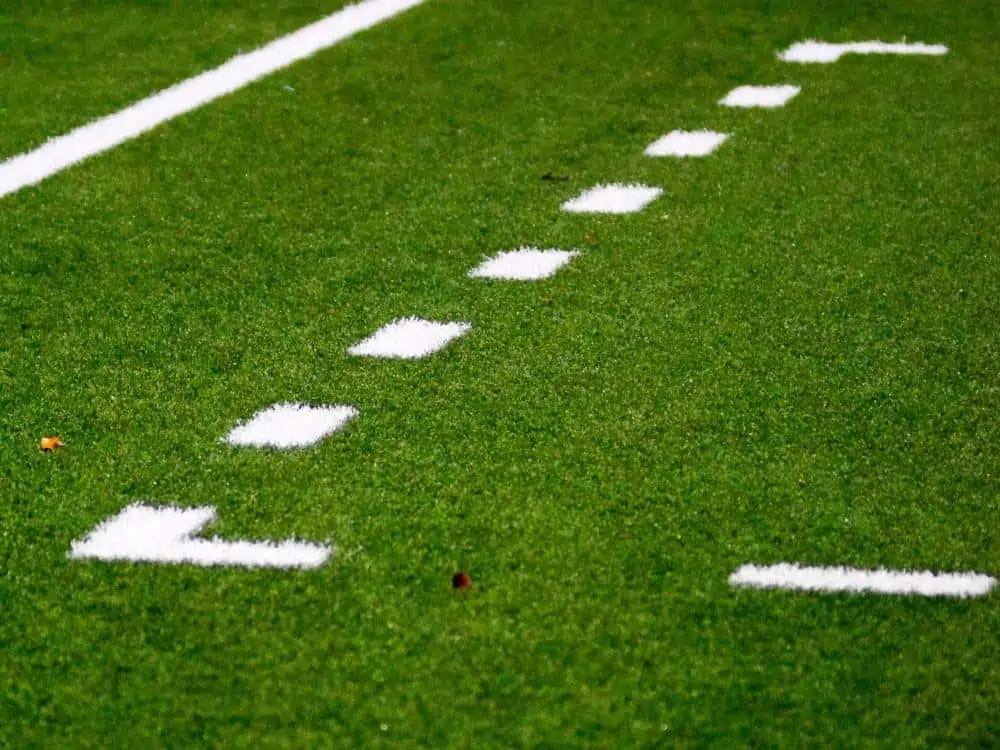
Area Around The Field
A 1.5m (1.6 yards) baseline of the field beyond the indicated playing area is required. The playing area should be 125m × 85m or 120m x 80m.
The exterior of each line is measured, which ought to be no more than 12cm broad and preferably match the width of the goal area.
Soccer Goal Post Dimensions
The height of a soccer goal is 8 feet/2.44 meters, and the width is 8 yards/7.32 meters.

The shape of the posts can vary from a square, rectangle, round or elliptical – professionals use round posts.
The width of the goalposts must be the same thickness as the lines – no more than 12 cm/5 inches. Check out these portable goals on Amazon, it only takes 3 minutes to set up!
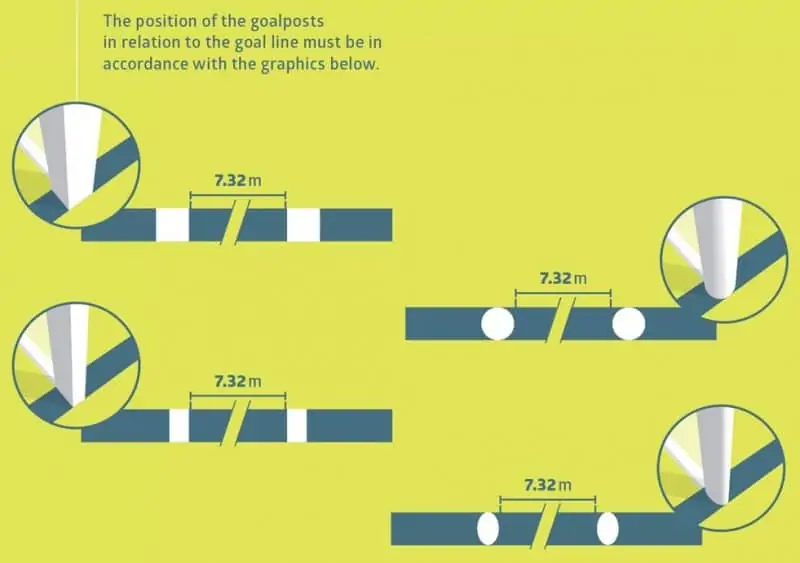
If you’re looking for full-sized soccer goals with wheels so that you can easily move them for training sessions, games, or so that they can be easily put to one side, read our article here.
Soccer Field FAQ
How many acres are in the soccer field?
1.76 acres.
What is the difference between a soccer field and a soccer pitch?
In the United States, the playing areas are called a field, whereas in the UK they call it a pitch.
Share the post "Soccer Field Dimensions/Markings (Pro/School/Youth)"
Joel is a seasoned soccer journalist and analyst with many years of experience in the field. Joel specializes in game analysis, player profiles, transfer news, and has a keen eye for the tactical nuances of the game. He played at various levels in the game and coached teams - he is happy to share his insight with you.



